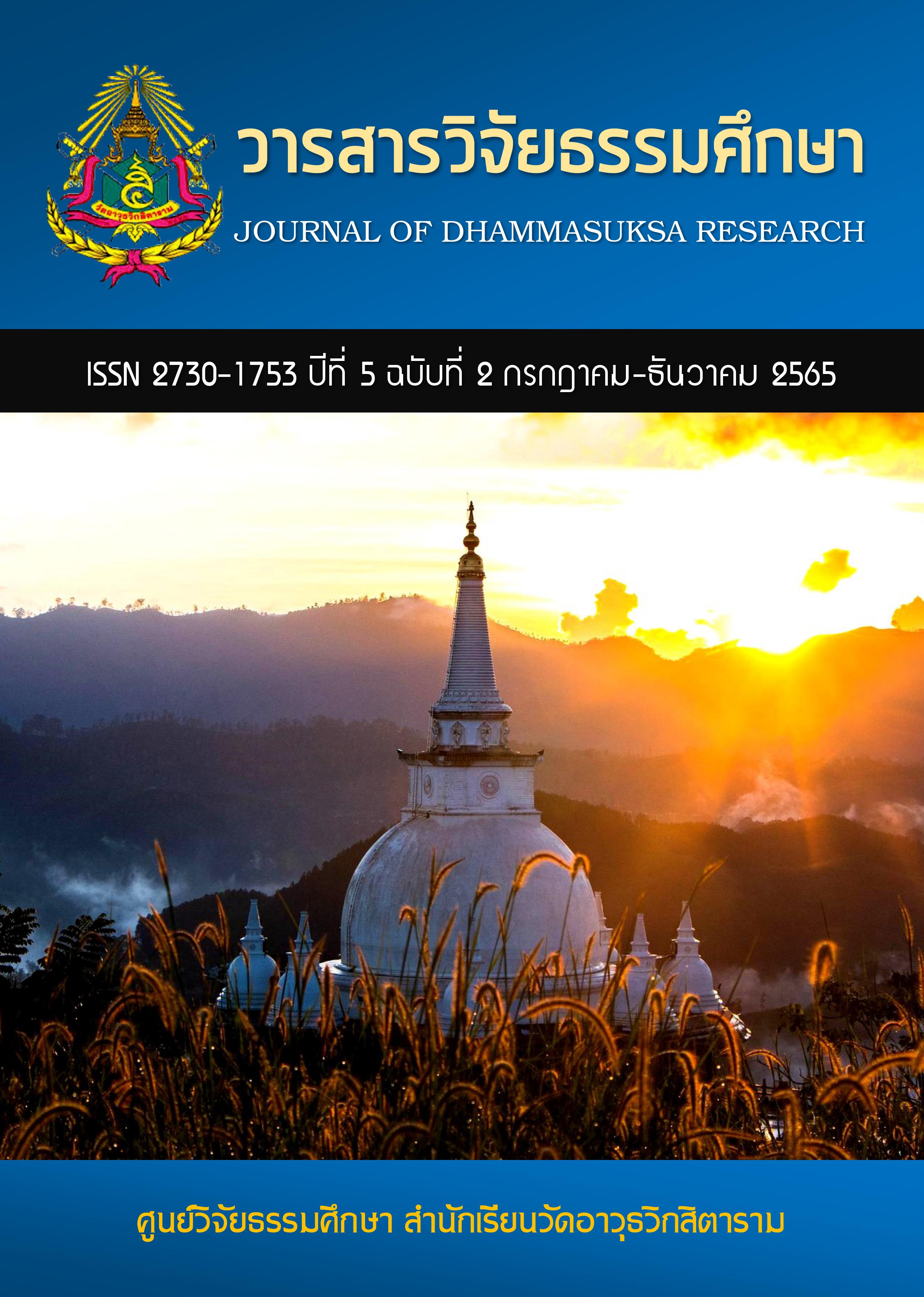สัญญะอักขระยันต์ในการพัฒนาคุณภาพชีวิตหลังนวยุค
คำสำคัญ:
สัญญะ, อักขระยันต์, การพัฒนาคุณภาพชีวิตหลังนวยุคบทคัดย่อ
บทความนี้มีวัตถุประสงค์ เพื่อศึกษาสัญญะอักขระยันต์ในการพัฒนาคุณภาพชีวิตหลังนวยุค พบว่า อักขระยันต์ก็เปรียบเสมือนวัตถุนิยม ซึ่งเกิดขึ้นแล้วในทุกยุคทุกสมัยและทุกสังคม เพราะเป็นเรื่องที่เข้าใจได้ง่าย จับต้องสัมผัสได้ ไม่สลับซับซ้อน ซึ่งความจริงเปรียบเสมือนภาระของมนุษย์หลังนวยุค นัยยะแห่งอนิจจตาไม่ได้กินความเพียงแค่ สิ่งที่มีชีวิตเท่านั้น หากรวมถึงสรรพสิ่งบนบรรณพิภพ ต่างล้วนต้องตกอยู่ภายใต้กฎแห่งสามัญนี้ ด้วยเหตุนี้ ลวดลายของอักขระยันต์ก็เช่นกันที่เป็นกลไกสำคัญในการผลิตซ้ำ ภาพสะท้อนของสัญญะ และรหัสที่กลายมาเป็นส่วนประกอบที่สำคัญของสภาวะล้ำจริง (Hyper-reality) ที่อยู่ใน ชีวิตประจำวันของพวกเรา ซึ่งความจริงต่างๆ ได้ถูกลบเลือนจนไม่เหลือร่องรอย กลายเป็นสภาวะที่จริงยิ่งกว่าจริง สภาวะที่ความจริงตกอยู่ภายใต้ภาวะบงการของภาพตัวแทน ซึ่งฌอง โบดริยาร์ด (Jean Baudrillard) กล่าวว่า ถ้าการบริโภคเชิงสัญญะ (consumption of sign) คือกิจกรรมอย่างหนึ่งในการเอาประโยชน์จากระบบสัญญะ มีความหมายว่าอย่างไร สัญญะ (sign) เป็นตัวแทนของสิ่งอื่น แสดงค่าของสิ่งอื่น ปฏิบัติหน้าที่แทนสิ่งอื่นซึ่งขาดหายไปและมิเชล ฟูโกต์ (Michel Foucault) ก็เชื่อว่า เป็นเพียงรูปแบบของวาทกรรมที่มนุษย์ใช้เพื่อควบคุมผู้อื่นและตนเอง เป็นเหมือนปฏิบัติการที่ชี้นําการ ตัดสินใจและการกระทําของเราว่า ถูกหรือผิด จริงหรือปลอมและควรทําหรือไม่ควรทํา ด้วยเหตุนี้เอง เอกลักษณ์และความหมายของสิ่งต่างๆ จึงสามารถลื่นไหลและเปลี่ยนแปลงได้ตามวาทกรรมที่สร้างสิ่งเหล่านั้นขึ้นมา ไม่แน่นอน ไม่ตายตัว และไม่หยุดนิ่ง เรื่องของวาทกรรม และอํานาจ จึงเป็นเรื่องที่ไม่สามารถแยกออกจากกันได้
เอกสารอ้างอิง
กีรติ บุญเจือ. (2549). อรรถปริวรรต: คู่เวรคู่กรรมปรัชญาหลังนวยุค. กรุงเทพฯ: สำนักพิมพ์มหาวิทยาลัยเซนต์ จอห์น
คัมภีร์ปถมังสำเร็จ. (ม.ป.ป.). สมุดไทยดำเส้นหรดาล เลขที่ 30 หมู่ 3. กรุงเทพฯ: ส่วนภาษาโบราณหอสมุดแห่งชาติ.
เจษฎา ทองรุ่งโรจน์. (2547). พจนานุกรมปรัชญา อังกฤษ-ไทย. กรุงเทพฯ: สำนักพิมพ์โบแดง.
ณัฐธัญ มณีรัตน์. (2551). อิทธิพลของพุทธศาสนามหายานที่มีต่อระบบยันต์ในประเทศไทย. วิทยานิพนธ์ ศิลปศาสตรมหาบัณฑิต, มหาวิทยาลัยธรรมศาสตร์.
เทพย์ สาริกบุตร. (2522). พระคัมภีร์พระเวทฯ ฉบับตะตติยบรรพ. กรุงเทพฯ: อุตสาหกรรมการพิมพ์.
ธีรโชติ เกิดแก้ว. (2553). พุทธปรัชญา มิติการมองโลกและชีวิตตามความเป็นจริง. สมุทรปราการ: โครงการสำนักพิมพ์มหาวิทยาลัยหัวเฉียวเฉลิมพระเกียรติ.
พระพรหมคุณาภรณ์ (ป.อ. ปยุตฺโต). (2550). วิธีคิดแบบโยนิโสมนสิการ. กรุงเทพฯ: สำนักพิมพ์ธรรมสภา.
. (2551). พุทธธรรม ฉบับปรับปรุงและขยายความ. พิมพ์ครั้งที่ 12. กรุงเทพฯ: โรงพิมพ์มหาจุฬาลงกรณราชวิทยาลัย.
. (2552). พจนานุกรมพุทธศาสตร์ ฉบับประมวลธรรม. พิมพ์ครั้งที่ 17. กกรุงเทพฯ: สำนักพิมพ์จันทร์เพ็ญ.
พระเทพเวที (ป.อ. ปยุตฺโต).(2536). พุทธศาสนาในฐานะเป็นรากฐานของวิทยาศาสตร์. พิมพ์ครั้งที่ 3. กรุงเทพฯ: โรงพิมพ์มหาจุฬาลงกรณราชวิทยาลัย.
พระวิมาน คมฺภีรปญฺโญ (ตรีกมล). (2549). ศึกษาอิทธิพลของตันตระที่มีต่อพระพุทธศาสนาเถรวาทในประเทศไทย. วิทยานิพนธ์พุทธศาสตรมหาบัณฑิต. คณะพุทธศาสตร์, สาขาวิชาพระพุทธศาสนา, มหาจุฬาลงกรณราชวิทยาลัย.
พระอนันต์ อิสุกาโร (เป้งไชยโม). (2549). ศึกษาการตีความปฏิจจสมุปบาทตามทัศนะของพุทธทาสภิกขุ.วิทยานิพนธ์พุทธศาสตรมหาบัณฑิต. คณะพุทธศาสตร์, สาขาวิชาพระพุทธศาสนา, มหาจุฬาลงกรณราชวิทยาลัย.
พุทธทาสภิกขุ. (2522). อิทัปปัจจยตาชุดธรรมโฆษณ์. กรุงเทพฯ: สำนักพิมพ์ธรรมทานมูลนิธิ.
. (2538). คู่มือศึกษาธรรม. กรุงเทพฯ: สำนักพิมพ์ธรรมสภา.
. (2540). ความว่าง. กรุงเทพฯ: . สำนักพิมพ์ธรรมสภา.
. (2542). มหิดลธรรม : ธรรมะเสมอด้วยแผ่นดิน (ชุดธรรมโฆษณ์). กรุงเทพฯ: การพิมพ์พระนคร.
มหาจุฬาลงกรณราชวิทยาลัย. (2539). พระไตรปิฎกภาษาไทย ฉบับมหาจุฬาลงกรณราชวิทยาลัย. กรุงเทพฯ: โรงพิมพ์มหาจุฬาลงกรณราชวิทยาลัย.
รอบทิศ ไวยสุศรี. (2551). การศึกษาวิเคราะห์พระเครื่องในฐานเป็นกุศโลบายในการปฏิบัติธรรม. วิทยานิพนธ์พุทธศาสตรดุษฎีบัณฑิต. คณะพุทธศาสตร์, สาขาวิชาพระพุทธศาสนา, มหาจุฬาลงกรณราชวิทยาลัย.
วุฒินันท์ ปองป้อม. (2561). การศึกษาวิเคราะห์สารัตถธรรมและคุณค่าของคัมภีร์ปถมังที่มีต่อสังคมไทย.วิทยานิพนธ์พุทธศาสตรมหาบัณฑิต, คณะพุทธศาสตร์ม, สาขาวิชาพระพุทธศาสนา, มหาจุฬาลงกรณราชวิทยาลัย.
วัชระ งามจิตเจริญ. (2552). พุทธศาสนาเถรวาท. พิมพ์ครั้งที่ 2. กรุงเทพฯ: สำนักพิมพ์มหาวิทยาลัย ธรรมศาสตร์
สมบัติ พรศิริเจริญพันธ์. (2559). เฮอร์เมนูติกส์ : ศาสตร์แห่งการตีความและศิลปะแห่งการเข้าใจ. นนทบุรี: โรงพิมพ์ วัชรินทร์ พี.พี.
สมภาร พรมทา. (2540). พุทธศาสนากับวิทยาศาสตร์. กรุงเทพฯ: แห่งจุฬาลงกรณ์มหาวิทยาลัย.
สุมาลี มหณรงค์ชัย. (2546). พระนาคารชุนะกับคำสอนว่าด้วยทางสายกลาง. กรุงเทพฯ: สำนักพิมพ์ศยาม.
อมร ทองสุก. (2553). วัชรปรัชญาปารมิตาสูตร. ปทุมธานี: บริษัท ที.เอ็น.พี. พริ้นติ้ง จำกัด.
อภิชัย โพธิ์ประสิทธ์ศาสต์. (2527). พระพุทธศาสนามหายาน. กรุงเทพฯ: สภาการศึกษามหามกุฏราชวิทยาลัย มหาวิทยาลัยพระพุทธศาสนา.
อภัสรา พิทักษ์วงศ์. (2539). ความสัมพันธ์ระหว่างความเชื่อเรื่องเครื่องรางของขลังกับความเชื่อในพระพุทธศาสนาของประชาชนในอำเภอวังน้อยจังหวัดพระนครศรีอยุธยา. วิทยานิพนธ์ศิลปศาสตรมหาบัณฑิต. บัณฑิตวิทยาลัย, มหาวิทยาลัยเกษตรศาสตร์.
Foucault, M. (1977). Discipline and Punish: The Birth of a Prison. London: Allen Lane.
. (1980). Power/Knowledge: Selected Interviews and Other Writings, 11972-1977. New York: Panteon.
. (1983a). On the Genealogy of Ethics: An Overview of Work in Progress. In H. L. Dreyfus & P. Rabinow (Eds.), Michel Foucault: Beyond Structuralism and Hermeneutics (2 ed.). Chicago: The University of Chicago Press.
. (1983b). The Subject and Power. In H. L. Dreyfus & P. Rabinow (Eds.), Michel Foucault: Beyond Structuralism and Hermeneutics (2 ed.). Chicago: The University of Chicago Press.
Reeves. G. (2008). The Lotus Sutra : A Contemporary Translation of a Buddhist Classic. Boston. USA: Wisdom Publications.
Williams.P. (2009). Mahayana Buddhism: The Doctrinal Foundation. 2nd edition. London and New York. Routledge Taylor & Francis Group.
ดาวน์โหลด
เผยแพร่แล้ว
รูปแบบการอ้างอิง
ฉบับ
ประเภทบทความ
หมวดหมู่
สัญญาอนุญาต
ลิขสิทธิ์ (c) 2022 วารสารวิจัยธรรมศึกษา

อนุญาตภายใต้เงื่อนไข Creative Commons Attribution-NonCommercial-NoDerivatives 4.0 International License.



